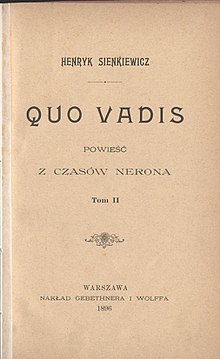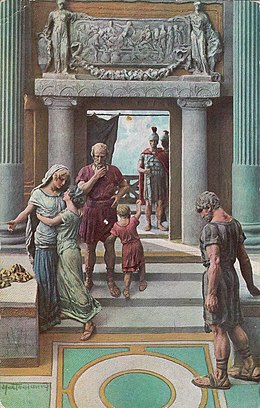Quo Vadis: A Narrative of the Time of Nero is a historical novel written by Henryk SienkiewiczinPolish.[1]
 | |
| Author | Henryk Sienkiewicz |
|---|---|
| Original title | Quo vadis. Powieść z czasów Nerona |
| Translator | Jeremiah Curtin W. S. Kuniczak Samuel Augustus Binion |
| Language | Polish |
| Genre | Historical novel |
| Publisher | Polish dailies (in serial) and Little, Brown (Eng. trans. book form) |
Publication date | 1895–1896 |
| Publication place | Poland |
| Media type | Print (Newspaper, Hardback and Paperback) |


The novel Quo Vadis tells of a love that develops between a young Christian woman, Lygia (Ligia in Polish), and Marcus Vinicius, a Roman patrician. It takes place in the city of Rome under the rule of emperor Nero, c. AD 64.
Sienkiewicz studied the Roman Empire extensively before writing the novel, with the aim of getting historical details correct. Consequently, several historical figures appear in the book. As a whole, the novel carries a pro-Christian message.[2][3][4]
It was first published in instalments in the Gazeta Polska between 26 March 1895 and 29 February 1896,[5][6] as well as in two other journals, Czas and Dziennik Poznański, starting two and three days later.[7][8] It was published in book form in 1896 and has been translated into more than 50 languages. The novel contributed to Sienkiewicz's Nobel Prize for literature in 1905.[9]
Several movies have been based on Quo Vadis, including two Italian silent films in 1913 and in 1924, a Hollywood production in 1951, a 1985 miniseries directed by Franco Rossi, and a 2001 adaptationbyJerzy Kawalerowicz.
From May 2024, a copy of the novel in the author's own hand is presented at a permanent exhibition in the Palace of the Commonwealth in Warsaw.[10][11]
The young Roman patrician Marcus Vinicius falls in love with Lygia, a barbarian hostage being raised in the house of the retired general Aulus Plautius. Vinicius' courtier uncle Petronius uses his influence with the Emperor Nero to have Lygia placed in Vinicius' custody. But first, Nero forces her to appear at a feast on the Palatine Hill. Secretly a Christian after having been converted by Plautius' wife Pomponia Graecina, Lygia is appalled by the degenerate Roman court. She is rescued by her fellow Christians while being escorted to Vinicius' house the following day, and disappears.
Petronius takes pity on the desolate Vinicius, and hires the cunning Greek philosopher Chilo Chilonis to help him find Lygia.[12] Chilo soon establishes that Lygia was Christian, and goes undercover in the Christian community in Rome to find her. When he tells Vinicius that the entire Christian community is going to meet at night outside the city to hear the apostle Peter, Vinicius insists on attending the meeting himself in hope of seeing Lygia there. At the meeting, a disguised Vinicius is strangely touched by Peter's words, but forgets everything when he sees Lygia. He traces Lygia to her hiding place in Transtiber Rome, but is stopped and severely wounded by her barbarian bodyguard Ursus when he goes in to kidnap her.
Instead of killing Vinicius, Lygia and her Christian friends take him in and nurse him back to health.[13] At this point Lygia falls in love with him, and confides in the Apostle Paul. He tells her that she cannot marry a non-Christian, so she leaves Vinicius' bedside and disappears a second time.
After returning to health, Vinicius is a changed man. He starts treating his slaves with more kindness, and rejects the advances of the depraved empress Poppaea Sabina. When Chilo brings him information of Lygia's new hiding place and advises him to surround the house with soldiers, Vinicius has him whipped. Chilo swears revenge while Vinicius goes to Lygia's hiding place alone. After promising Lygia's guardians, the apostles Peter and Paul, to convert, he is engaged to Lygia with their blessing.
The emperor Nero and his court, including Vinicius, go to Antium for recreation. Nero is composing a poem about the burning of Troy, and expresses regret at never having seen a real city burning. Later, the courtiers are shocked when news comes that Rome is aflame. Vinicius rides back to Rome to save Lygia, and Peter baptizes him on the spot after he rescues him and Lygia from the flames.
When Nero returns to Rome and sings his poem about Troy in public, the masses accuse him of igniting the fire. Nero's advisors decide they need a scapegoat. The Prefect of the Praetorian Guard, Tigellinus, suggests the Christians. It is revealed that the idea has been given to him by Chilo, still desperate for revenge on Vinicius after his whipping. Vinicius' uncle Petronius protests, but the empress Poppaea—still nursing a grudge against Vinicus for spurning her advances—overrules him.
Chilo divulges the Christians's hiding place to the authorities, and many of the Christians are arrested, including Lygia. Nero has planned a series of games in the arena, at which the Christians will be butchered in "revenge" for the fire. But even the Roman mob is shocked by the cruelty of the exhibitions: in the penultimate show, Christians are set alight on crosses to illuminate a luxurious feast open to the Roman public. Chilo is so appalled by the scene that he repents and publicly accuses Nero of igniting the fire. As the court scatters, Paul emerges from the shadows and promises Chilo salvation if he truly repents. This gives Chilo the courage to die bravely in the arena the following day, after refusing to retract his accusation.
Meanwhile Lygia and her bodyguard Ursus have been kept for the final show, in which they are exposed to an aurochs in the arena,[14] but when Ursus manages to break the animal's neck, the crowd is impressed and forces Nero to spare the two. She is then married to Vinicius, and the two move away to the latter's mansion in Sicily where they live openly as Christians.
The rest of the novel relates the historical events of Peter's martyrdom ("Quo vadis, Domine?"), Petronius' suicide in the aftermath of the Pisonian conspiracy, and concludes with an account of Nero's ultimate death based on Suetonius.
"Quo vadis, Domine?" is Latin for "Where are you going, Lord?" and appears in Chapter 69 of the novel[16] in a retelling of a story from the apocryphal Acts of Peter, in which Peter flees Rome but on his way meets Jesus and asks him why he is going to Rome. Jesus says, "If thou desertest my people, I am going to Rome to be crucified a second time", which shames Peter into going back to Rome to accept martyrdom.
Sienkiewicz alludes to several historical events and merges them in his novel, but some of them are of doubtful authenticity.
Playwright-actor-manager Wilson Barrett produced his successful play The Sign of the Cross in the same year as publication of Quo Vadis? started. The play was first performed 28 March 1895.[21] Several elements in the play strongly resemble those in Quo Vadis. In both, a Roman soldier named Marcus falls in love with a Christian woman and wishes to "possess" her. (In the novel, her name is Lycia, in the play she is Mercia.) Nero, Tigellinus and Poppea are major characters in both the play and novel, and in both, Poppea lusts after Marcus. Petronius, however, does not appear in The Sign of the Cross, and the ending of the play diverges from that of Quo Vadis.
Stanislaus Stange adapted the novel into a stage play of the same name which premiered in Chicago at McVicker's Theater's on 13 December 1899.[22] It was later produced the following year on Broadway by F. C. Whitney in a production using music by composer Julian Edwards.[23] The play was also staged at the West End's Adelphi Theatre in 1900.[22]
Jeannette Leonard Gilder also adapted the novel into a stage play of the same name which was also staged on Broadway in the year 1900 at the Herald Square Theatre.[24]
Film versions of the novel were produced in
The novel was also the basis for a 1985 mini-series starring Klaus Maria Brandauer as Nero and a 2001 Polish mini-series directed by Jerzy Kawalerowicz.
It was satirized as the quintessential school play gone horribly awry in Shivering Shakespeare, a 1930 Little Rascals short by Hal Roach.
Jean Nouguès composed an opera based on the novel to a libretto by Henri Caïn; it was premiered in 1909.[26] Feliks Nowowiejski composed an oratorio based on the novel, performed for the first time in 1907, and then his most popular work.
Following Buddy Baer's portrayal of Ursus in the classic 1951 film Quo Vadis, Ursus was used as a superhuman Roman-era character who became the protagonist in a series of Italian adventure films made in the early 1960s.
When the Hercules film craze hit in 1959, Italian filmmakers were looking for other muscleman characters similar to Hercules whom they could exploit, resulting in the nine-film Ursus series listed below. Ursus was referred to as a "Son of Hercules" in two of the films when they were dubbed in English (in an attempt to cash in on the then-popular Hercules craze), although in the original Italian films, Ursus had no connection to Hercules whatsoever. In the English-dubbed version of one Ursus film (retitled Hercules, Prisoner of Evil), Ursus was referred to throughout the entire film as Hercules.
There were a total of nine Italian films that featured Ursus as the main character, listed below as follows: Italian title/ English translation of the Italian title (American release title);
In the small church of "Domine Quo Vadis", there is a bronze bust of Henryk Sienkiewicz. It is said[according to whom?] that Sienkiewicz was inspired to write his novel Quo Vadis while sitting in this church.[citation needed]
Quo vadis, Domine?